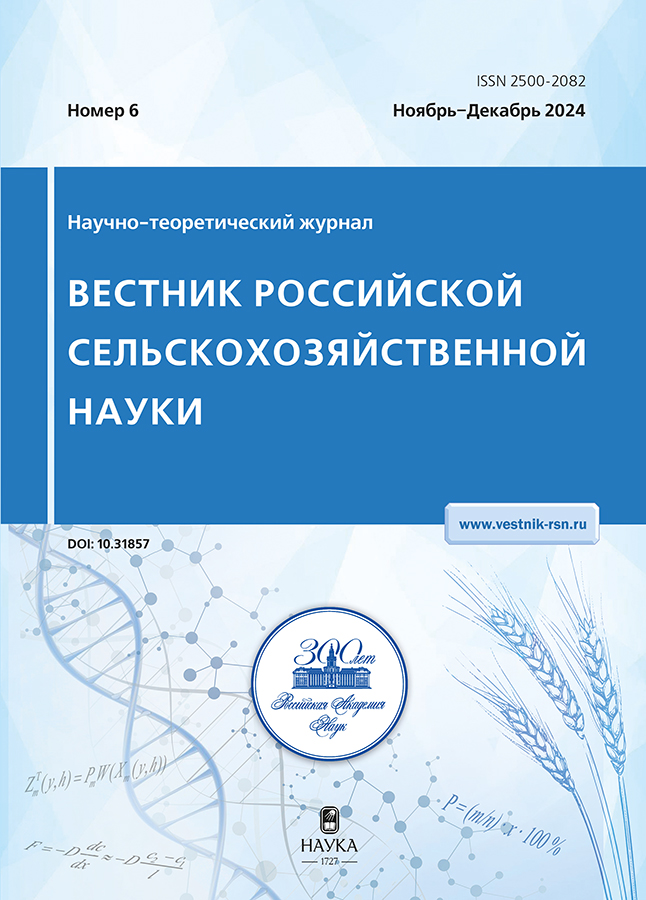Management of soil organic matter regime in biologization of agriculture
- Authors: Savchenko E.S.1, Lukin S.V.2,3
-
Affiliations:
- Russian Academy of Sciences
- Belgorod State National Research University
- Belgorod Center for Agrochemical Service
- Issue: No 6 (2024)
- Pages: 62-65
- Section: Farming
- URL: https://vietnamjournal.ru/2500-2082/article/view/659227
- DOI: https://doi.org/10.31857/S2500208224060147
- EDN: https://elibrary.ru/WTHZSC
- ID: 659227
Cite item
Abstract
All related research was conducted from 2010 to 2022 in the Belgorod region, located in the south-west of the Central Chernozem region (CCR). The goal of this study was to analyze the effects of introducing agriculturally biologized elements into arable soils on the organic matter content of those same soils. It was determined, that compared to their virgin counterparts, unwashed arable chernozems, typical and leached, had lost about 39.8–42.0% of their organic matter due to long-term agricultural use. In comparison to 2010–2014, the level of organic fertilizer input had doubled to 9,6 t/ha in 2019–2022, while the area of green manure cultures had increased by a factor of 2.56 to 317 thousand ha/year. Concurrently to the aforementioned years, the by-product output increased by 18.8–37.6% (depending on the crop), reaching levels between 2.07–10.3 t/ha, due to an increase in agricultural yield. The area of ley farms decreased by a factor of 2.73 down to 47.1 thousand ha/year. Additionally, a wide percentage of the Belgorod region have implemented low tillage technology usage, including no-till and executed complex anti-erosion activities. As a result of that, in 2019–2022, the average content of organic matter in the arable layer of soils went up by 0.3% (to 5.3%), while reserve by 9 t/ha (to 159 t/ha). Each hectare of the cultivated areas on average accumulated 19 carboxylic units, thereby making it worth about 19 thousand rubles. The percentage of soils, which contain 6.1–8.0% of organic matter, rose to 20.0%, while those containing 2.1–4.0%, were reduced to 10.9%.
Keywords
Full Text
About the authors
E. S. Savchenko
Russian Academy of Sciences
Email: serg.lukin2010@yandex.ru
Corresponding Member of the RAS
Russian Federation, MoscowS. V. Lukin
Belgorod State National Research University; Belgorod Center for Agrochemical Service
Author for correspondence.
Email: serg.lukin2010@yandex.ru
ORCID iD: 0000-0003-0986-9995
Grand PhD in Agricultural Sciences, Professor
Russian Federation, Belgorod; BelgorodReferences
- Dergacheva M.I. Tradicii i novatorstvo v Uchenii o gumuse pochv // Pochvy i okruzhayushchaya sreda. 2021. T. 4. № 4. 172 s. https://doi.org/10.31251/pos.v4i4.172
- Dokuchaev V.V. Russkij chernozem. M.: «Kniga po Trebovaniyu», 2012. 559 s.
- Ivanov A.L. i dr. Rekomendacii po proektirovaniyu integrirovannogo primeneniya sredstv himizacii v resursosberegayushchih tekhnologiyah adaptivno-landshaftnogo zemledeliya: instruktivno-metodicheskoe izdanie. M.: «Rosinformagrotekh», 2010. 464 s.
- Kiryushin V.I. Metodologiya zemlepol’zovaniya i zemleustrojstva na landshaftno-ekologicheskoj osnove, SPb.: OOO “Kvadro”, 2024. 336 s.
- Lukin C.B., Solovichenko V.D. Rezul’taty monitoringa plodorodiya pochv gosudarstvennogo zapovednika “Belogor’e” // Dostizheniya nauki i tekhniki APK. 2008. № 8. S. 15–17. EDN: JWVMAP.
- Pochvy. Terminy i opredeleniya. GOST 27593-88. M.: Standartinform, 2006. 11 s.
- Savchenko E.S. Vystuplenie Gubernatora Belgorodskoj oblasti, chlena-korrespondenta RAN E.S. Savchenko // Vestnik Rossijskoj akademii nauk. 2019. T. 89. № 5. S. 525–526. https://doi.org/10.31857/S0869-5873895525-526
- Semyonov V.M., Kogut B. M. Pochvennoe organicheskoe veshchestvo. M.: GEOS, 2015. 223 s.
- Solovichenko V.D. Plodorodie i racional’noe ispol’zovanie pochv Belgorodskoj oblasti. Belgorod: Otchij dom, 2005. 292 s.
- Sychyov V.G., Aristarhov A.N., Volodarskaya I.V. i dr. Metodicheskie ukazaniya po provedeniyu kompleksnogo monitoringa plodorodiya pochv zemel’ sel’skohozyajstvennogo naznacheniya. M.: MSH, 2003. 195 s.
- Chekmaryov P.A. Sostoyanie plodorodiya pochv i meropriyatiya po ego povysheniyu v 2012 g. // Agrohimicheskij vestnik. 2012. № 1. S. 2–4.
- Elektronnyj resurs. http://www.fedstat.ru/indicators/stat.do (data obrashcheniya 24.04.2023).
- Lehmann J., Kleber M. The contentious nature of soil organic matter. Nature. 2015. Vol. 528. p. 60–68. https://doi.org/10.1038/nature16069
- Lukin S.V. Dynamics of Agroecological State of Soils in the Belgorod Region during Long-Term Agricultural Use // Eurasian Soil Science. 2023. Vol. 56. No. 12. P. 1986–1998. https://doi.org/10.1134/s1064229323602123
- Malysheva E.S. Application of geoinformation systems for a complex analysis of data from agrochemical and soil-erosion monitoring of soils, Bio web of conferences: International Scientific and Practical Conference “Fundamental Scientific Research and Their Applied Aspects in Biotechnology and Agriculture” (FSRAABA 2021), EDP Sciences, Tyumen, 19–20 July (2021), 36, 03016. https://doi.org/10.1051/bioconf/20213603016
- Malysheva E.S., Malyshev A.V., Kostin I.G. Complex Analysis of Data from Agrochemical and Soil-Erosion Monitoring Using Geoinformation Systems // IOP Conference Series: Earth and Environmental Science, Ussurijsk, 20–21 июня 2021 года. Ussurijsk. P. 032070. https://doi.org/10.1088/1755-1315/937/3/032070
Supplementary files










